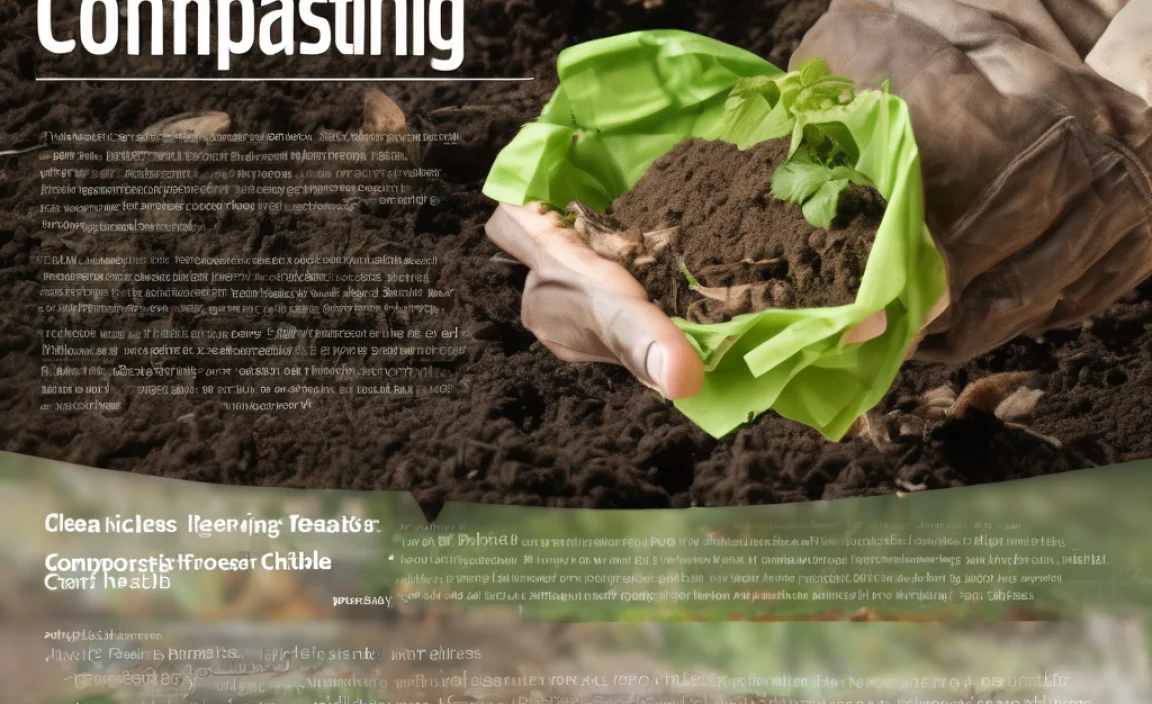Ever thought about composting but pictured a big, smelly pile in the backyard? If you live in an apartment or just don’t have much outdoor space, that’s a bummer. But what if I told you there’s a neat, tidy way to make nutrient-rich compost right inside your home?
Yes, it’s totally doable! We’re diving into all things indoor composting, making it super easy to get started. We’ll explore what you need, how it works, and where to find the right gear. Get ready to turn kitchen scraps into garden gold without leaving your house!
Indoor Composting Stores: Your Super Simple, Super Smart Guide
Hey there, composting curious friends! Troy D Harn here from TopChooser, ready to demystify the world of indoor composting. If you’ve been eyeing those lush houseplants or dreaming of a tiny herb garden on your windowsill and thought, “But where do I get compost?”, this guide is for you. Many people think composting is an outdoor-only activity, reserved for those with sprawling gardens. But the truth is, you can absolutely compost indoors, and it’s much cleaner and simpler than you might imagine. We’ll cover everything from understanding the different types of indoor composting systems to finding exactly what you need. Let’s get that good stuff brewing!
Why Compost Indoors? The Big Picture
Composting is like magic for your plants. It’s a natural process where organic materials break down into a rich, soil-like substance called compost, or humus. This stuff is pure gold for your plants, providing essential nutrients and improving soil structure. But for many of us, especially those living in apartments or smaller homes, a traditional outdoor compost bin just isn’t practical. That’s where indoor composting shines! It allows you to:
- Reduce kitchen waste significantly, diverting food scraps from landfills.
- Create your own natural fertilizer for houseplants, balcony gardens, or even small urban plots.
- Feel great about contributing to a more sustainable lifestyle.
- Avoid the mess, smells, and pests sometimes associated with outdoor composting.
Think of it as a smart, eco-friendly way to manage your waste and nurture your greenery, all from the comfort of your home. It’s about making sustainability accessible, no matter your living situation.
Decoding Indoor Composting: What Are Your Options?
When we talk about “indoor composting stores,” we’re really talking about places that sell the tools and systems designed for composting in smaller, controlled environments. The most common and beginner-friendly methods are:
1. Vermicomposting (Worm Composting)
This is probably the most popular method for apartment dwellers. It uses red wiggler worms (not earthworms!) to munch on your food scraps. These worms are super efficient eaters and produce incredibly nutrient-rich castings (worm poop!), which is a fantastic fertilizer.
How it generally works:
- You get a worm bin, which is usually a multi-tiered plastic container designed for airflow and drainage.
- You add bedding material, like shredded newspaper or coconut coir.
- You add your red wiggler worms.
- You feed them your kitchen scraps (veggie peels, fruit scraps, coffee grounds, tea bags – but no meat, dairy, or oily foods).
- The worms eat the scraps and bedding, and their castings fall to the bottom, ready to be harvested.
What to look for when buying a worm composting system:
- Size: A bin that fits your space and the amount of food waste you generate. Many multi-tier systems expand.
- Material: Durable, food-grade plastic is common and easy to clean.
- Ventilation: Good airflow is crucial to keep the environment healthy for the worms.
- Drainage: A way to collect any excess liquid (worm tea), which is also a potent plant fertilizer.
For more in-depth guides on vermicomposting, the U.S. Environmental Protection Agency (EPA) offers great resources on composting basics.
2. Bokashi Composting
Bokashi is a bit different. It’s a type of fermenting process that uses a special Bokashi bran inoculated with Effective Microorganisms (EM). It pickles your food waste rather than decomposing it directly.
How it generally works:
- You place food scraps (including meat, dairy, and oils – which is a big plus!) into an airtight Bokashi bucket.
- You sprinkle Bokashi bran over the scraps.
- You press the scraps down to remove air.
- You add more scraps and bran until the bucket is full.
- You seal the bucket and let it ferment for about two weeks.
- After fermentation, the “pre-compost” is buried in soil (garden or a large planter) or added to a traditional compost bin to fully break down.
What to look for when buying a Bokashi system:
- Airtight Bucket: Essential for the fermentation process. They usually have a spigot at the bottom to drain the Bokashi liquid.
- Bokashi Bran: You’ll need to purchase this as you use it up for each layer.
- Easy to Clean: Look for sturdy construction.
Bokashi is a great option if you generate a lot of food waste and want to compost things like meat and dairy, but remember the final step involves adding the fermented material to soil outdoors or in a larger system.
3. Electric Composters (Food Cyclers)
These modern appliances are like a futuristic take on composting. They use heat, aeration, and grinding to rapidly break down food scraps, often in just a few hours.
How it generally works:
- You add your food scraps (many can handle meat, dairy, and even some bones) into the appliance’s bucket.
- You close the lid and press a button.
- The machine heats, dries, and grinds the scraps, significantly reducing their volume and turning them into a nutrient-rich soil amendment.
What to look for in an electric composter:
- Capacity: How much food waste can it process at once?
- Processing Time: How quickly does it turn scraps into amendment?
- Odor Control: Most use carbon filters to keep things smelling fresh.
- Ease of Cleaning: Is the bucket removable and dishwasher-safe?
- Energy Consumption: Check the power usage.
These are the fastest and easiest options, but also typically the most expensive upfront. They don’t technically compost in the traditional sense but transform waste into a usable soil additive.
Where to Find Your Indoor Composting Tools: The “Stores”
When I mention “indoor composting stores,” I’m not usually talking about a single, giant retail chain solely dedicated to, say, worm bins. Instead, it’s about where you can find the best selection of indoor composting systems and supplies. Think of these as your go-to places:
1. Online Retailers (Amazon, Specialized Composting Sites)
This is often your best bet for variety and convenience. Online marketplaces offer a huge range of worm bins, Bokashi kits, and electric composters from countless brands. You can easily compare prices, read reviews, and find exactly what fits your needs and budget.
Pros:
- Vast selection.
- Convenient home delivery.
- Easy price comparison and reviews.
- Find specialized items like specific worm bedding or EM bran.
Cons:
- Can’t see the product physically before buying.
- Shipping times can vary.
You can find reputable brands like Worm Factory, Urbalive, and various Bokashi USA kits on these platforms. Always check seller reviews for reliability!
2. Garden Centers and Nurseries
Many local garden centers carry worm composting bins, especially during spring and summer. You might also find Bokashi systems or even electric composters, though selection can be more limited than online. It’s a great option if you want to see a bin in person or get advice from staff.
Pros:
- See and touch the products.
- Immediate purchase.
- Local expert advice.
Cons:
- Limited selection.
- Potentially higher prices than online.
- Seasonal availability for some items.
3. Home Goods and Appliance Stores
For electric composters, your best bet might be larger home goods stores or appliance retailers. Brands like Lomi, Vitamix (which makes an electric composter), and Pela make these units. You might see them in showrooms as they are more of a kitchen appliance.
Pros:
- See high-tech appliances in person.
- Often have demonstration units.
Cons:
- Likely only carry electric models.
- Focus is on the appliance, not necessarily the composting science itself.
4. Sustainable Living and Eco-Friendly Shops
Some cities have specialty stores focused on sustainability, zero-waste living, or eco-friendly products. These shops are fantastic places to find high-quality, often aesthetically pleasing, indoor composting solutions and get passionate advice.
Pros:
- Curated selection of quality products.
- Knowledgeable staff passionate about sustainability.
- Support local businesses.
Cons:
- Can be more expensive.
- Availability depends heavily on your location.
5. Direct from Manufacturers
Many popular brands of worm bins, Bokashi systems, or electric composters sell directly through their own websites. This can sometimes offer exclusive bundles, deals, or the latest models.
Pros:
- Access to the latest models and specialized parts.
- Direct customer support from the manufacturer.
- Potential for exclusive deals.
Cons:
- Need to know the specific brand you’re looking for.
- Shipping costs can vary.
Essential Accessories and Supplies
Once you’ve chosen your indoor composting system, you’ll need a few bits and bobs to get it running smoothly. These are also things you’ll find in the places we just discussed.
For Vermicomposting (Worm Bins):
- Red Wiggler Worms: You can often buy these online or from specialized suppliers. Start with about a pound of worms.
- Bedding Material: Shredded newspaper (avoid glossy print), cardboard, coconut coir (often sold in compressed bricks), or peat moss.
- Worm Food Scraps: Your collected kitchen waste.
- A Spray Bottle: To keep the bedding moist.
- A Small Trowel or Scoop: For harvesting castings.
- Optional: Worm Bin Additives: Crushed eggshells (for grit and calcium) or specific worm food boosters.
For Bokashi Composting:
- Bokashi Bran: This is crucial and needs to be purchased. It contains the beneficial microbes.
- Airtight Bokashi Bucket(s): You’ll need at least two if you want to continuously ferment batches.
- A Container for the fermented output: For the final decomposition stage.
For Electric Composters:
- Food Scraps: Most accept a wide range.
- Replacement Carbon Filters: For odor control, you’ll need to replace these periodically.
Many of these supplies can be found on Amazon or directly from the manufacturers of your chosen system. Local garden centers might carry coco coir and trowels.
Indoor Composting vs. Traditional Composting: A Quick Comparison
To really appreciate the genius of indoor composting, let’s see how it stacks up against the backyard method.
| Feature | Indoor Composting (Worm Bin/Bokashi) | Traditional Outdoor Composting |
|---|---|---|
| Space Required | Small countertop, balcony, or utility area. Ideal for apartments. | Requires yard space for a bin or pile. |
| Speed | Worms: Weeks to months for harvest. Bokashi: 2 weeks fermentation + final breakdown. | Weeks to months, depending on method, materials, and conditions. |
| Materials Accepted | Worms: Veggies, fruits, coffee grounds, tea. No meat, dairy, oils. Bokashi: Can handle meat, dairy, oils (after fermentation). | Generally accepts a wider range of yard waste and permitted food scraps. |
| Odor | Little to no odor if managed correctly. Earthy smell is normal for worms, minimal for Bokashi before final stage. | Can attract pests and produce odors if not balanced or managed well. |
| Effort | Regular feeding and monitoring for worms. Layering and draining for Bokashi. Electric composters are very low effort. | Requires turning, moisture management, and balance of greens/browns. |
| Output | Worm castings (super fertilizer), Bokashi liquid (fertilizer), fermented “pre-compost”. | Finished compost (rich soil amendment). |
| Cost | Initial setup can range from $50-$150 for worm bins, $50-$100 for Bokashi kits, $300+ for electric. Ongoing cost for worm bedding, Bokashi bran, or filters. | Can be low cost (DIY bin) to moderate ($50-$200 for pre-made bins). Mainly ongoing material costs if needed for balance. |
Tips for Success from Troy D Harn
Alright, let’s get down to brass tacks. Here are a few pointers to make your indoor composting journey a breeze:
- Start Small: Don’t feel like you need the biggest system right away. A small worm bin can handle a surprising amount of scraps from one or two people.
- Learn Your Worms (or Microbes!): If you go with vermicomposting, educate yourself on what red wigglers like to eat and what to avoid. For Bokashi, understand the role of the bran.
- Balance is Key: For worms, it’s about the right moisture and not overfeeding. For Bokashi, it’s about layering and sealing. For electric, it’s about following the instructions.
- Harvest Regularly: Don’t let your compost pile up too much. Harvesting finished compost (or emptying your electric composter) keeps the system working efficiently.
- Know Your “Greens” and “Browns” (for worm bins): Kitchen scraps (veggies, fruits, coffee) are “greens” (nitrogen-rich). Bedding materials like shredded paper or cardboard are “browns” (carbon-rich). You need a good mix for worms to thrive. Aim for roughly 50/50 by volume.
- Troubleshoot Early: If you notice odd smells or unhappy worms, address it quickly. Often, it’s a sign of too much moisture, too much food, or the wrong type of food. Quick research and adjustments can save your system.
- Be Patient: Composting is a natural process. It takes time. Celebrate the small wins, like seeing your scraps disappear or the nutrient-rich output you create.
Troubleshooting Common Indoor Composting Issues
Even with the best intentions, things can sometimes go a little sideways. Don’t freak out! Here are a few common hiccups and how to fix them:
- Smelly Bin (Worm Bin): This is usually a sign of an anaerobic (lack of oxygen) or “sour” environment.
- Cause: Too much food added at once, too much moisture, or not enough airflow.
- Fix: Bury food scraps more deeply under the bedding, stop feeding for a week or two, add more dry “brown” bedding material (shredded cardboard/paper), and ensure ventilation holes are clear.
- Fruit Flies (Worm Bin): These little pests love exposed food scraps.

I am passionate about home engineering. I specialize in designing, installing, and maintaining heating, ventilation, and air conditioning systems. My goal is to help people stay comfortable in their homes all year long.



